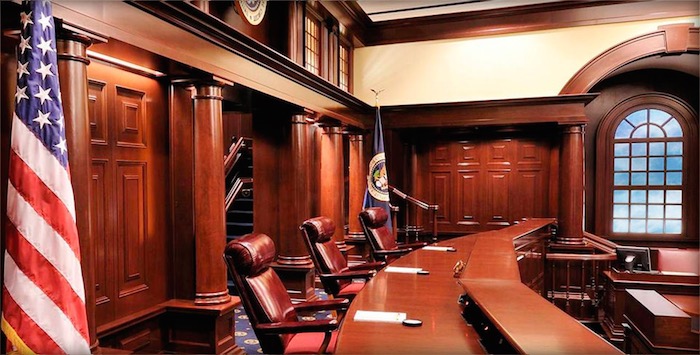“Rule 703 does not authorize admitting inadmissible evidence on the pretense that it is the basis for expert opinion when, in fact, the expert adds nothing to the inadmissible evidence other than transmitting it to the jury.”
 On April 6, the United States Court of Appeals for the Federal Circuit (CAFC) affirmed the decision of the United States District Court for the District of Delaware, holding that Sharp Electronics Corporation (Sharp) and Vizio Inc. did not infringe Wi-LAN, Inc.’s U.S. Patent No. 6,359,654 (“the ‘654 patent”) or U.S. Patent No. 6,490,250 (“the ‘250 patent”).
On April 6, the United States Court of Appeals for the Federal Circuit (CAFC) affirmed the decision of the United States District Court for the District of Delaware, holding that Sharp Electronics Corporation (Sharp) and Vizio Inc. did not infringe Wi-LAN, Inc.’s U.S. Patent No. 6,359,654 (“the ‘654 patent”) or U.S. Patent No. 6,490,250 (“the ‘250 patent”).
On May 11, 2015, Wi-LAN sued Sharp, alleging direct and induced infringement of claims 1, 4, and 9 of the ‘654 patent and claims 1, 4, and 6 ‘of the 250 patent. Soon thereafter, on September 8, 2015, Wi-LAN filed a similar complaint against Vizio alleging infringement of the same claims of the ‘654 and ‘250 patents. Though the two suits were similar, the district court did not consolidate the cases, but rather managed them in parallel. On February 27, 2018, the district court issued an order construing certain terms of the ‘654 patent and the ‘250 patent. Following the district court’s claim construction order, Wi-LAN conceded that it “could not prove infringement of the asserted claims of the ‘250 patent” under the district court’s interpretation of the terms “outpost multimedia data stream” and “a multimedia processor, coupled to the data rate analyzer.” Therefore, the district court entered a stipulated judgment of noninfringement of the ‘250 patent. With respect to the ‘654 patent, Wi-LAN alleged both direct and induced infringement. The parties filed cross-motions for summary judgment, and the district court granted Sharp and Vizio’s motion due to the fact that Wi-LAN was “unable to present sufficient admissible evidence to prove direct infringement.” Wi-Lan appealed each case, and the CAFC consolidated the appeals.
The ‘654 Patent
Wi-LAN attempted to admit as evidence of infringement what it purported to be a source code printout that it obtained from third-party chip manufacturers. However, the district court held that this evidence was inadmissible. On appeal, Wi-LAN argued four theories as to why the district court erred in not admitting the source code printout.
1. Business Record Exception
First, Wi-LAN argued that the source code printout constituted a business record and was therefore admissible under the business records exception to the hearsay rule under Rule 803(6) of the Federal Rules of Evidence. Citing Crash Dummy Movie, LLC, the CAFC noted that “[t]he business records exception allows admission of records of regularly conducted activity through the testimony of a custodian or other qualified witness.” Crash Dummy Movie, LLC v. Mattel, Inc., 601 F.3d 1387, 1392 (Fed. Cir. 2010). The CAFC stated that to qualify for this exception under Rule 803(6), Wi-LAN needed to establish by testimony from a custodian or another qualified witness that the source code printout satisfied the requirements of the Rule. Wi-LAN contended that it properly authenticated the source code printout through the declarations of chip manufacturers’ employees. However, the CAFC agreed with the district court that “the declarations could not be used to authenticate the source code printout” because “the declarations were a proxy for trial testimony.” Though, Wi-LAN argued that declarations are typically used at summary judgment as a proxy for trial testimony, declarations cannot be used for this purpose unless witnesses will be available to testify at trial. Since, when asked, Wi-LAN conceded that it could not force the declarants to appear at trial, Wi-LAN did not establish that the declarants would be available to testify at trial, and therefore the declarations could not be used as a substitute for trial testimony.
Additionally, Wi-LAN argued that it properly authenticated the source code printout because the declarations were “custodial declarations” and were themselves admissible under Rule 803(6). However, the CAFC rejected this as well because Wi-LAN admitted to obtaining the source code printout and declarations by filing lawsuits against manufacturers and dismissing those suits after being provided with the source code printout and declarations. Therefore, these materials do not qualify as a “record [that] was kept in the course of a regularly conducted activity of business.”
Alternatively, Wi-LAN argued that “under Third Circuit law,” the deficiencies in the declarations do “not preclude their use.” This argument is based on the In re Japanese Electric decision, which held that testimony of a custodian or other qualified witness under 803(6)(D) “can be met by documentary evidence, affidavits, or admission of the parties, i.e., by circumstantial evidence, or by a combination of direct and circumstantial evidence,” because “it would make little sense to require a live witness every time a business record is offered.” In re Japanese Elec. Prods. Antitrust Litig., 723 F.2d 238, 288 (3d Cir. 1983). However, even under this approach, the CAFC reasoned that “the declarations do not suffice because Wi-LAN does not meet Rule 803(6)’s final requirement” that the method or circumstance of preparation not indicate a lack of trustworthiness. As the district court concluded, “Sharp and Vizio ‘demonstrated a lack of trustworthiness in the materials; the source code contains inconsistent dates in the metadata, copyright and revisions histories as well as added commentary on the printed excerpts.’”
2. Rule 901(b)(4)
Wi-LAN argued that the source code should be admissible under Federal Rule of Evidence 901(b)(4), which permits a record to be admitted if the “the appearance, contents, substance, internal patterns, or other distinctive characteristics of the item, taken together with all the circumstances support a finding that the item is what the proponent claims it to be.” To support their argument, Wi-LAN stated, “there was no legitimate reason to question the trustworthiness of the source code.” However, the CAFC ruled that the district court did not abuse its discretion in ruling against this argument due to the “highly dubious circumstances surrounding the production” of the source code printout.
3. Rule 703
Under Federal Rule of Evidence 703, Wi-LAN argued that their expert, who did not attempt to authenticate the source code printout, should be able to opine on the meaning of the inadmissible source code printout and provide it to the jury despite Wi-LAN’s failure to authenticate the source code printout. This argument presented two questions for the CAFC: (1) whether the source code printout was admissible because it was relied upon by the expert, and (2) whether the expert’s testimony relying on the source code was admissible to establish infringement.
The CAFC stated that the answer to the first question is no “because expert reliance does not translate to admissibility.” The CAFC reasoned that “[r]ule 703 does not authorize admitting inadmissible evidence on the pretense that it is the basis for expert opinion when, in fact, the expert adds nothing to the inadmissible evidence other than transmitting it to the jury.”
As to the second question, the CAFC answered “no” as well. Citing Power Integrations, Inc., the CAFC reasoned that “data relied on by the expert need not be admissible for the opinion to be admitted if experts in the field would reasonably rely on such data.” Power Integrations, Inc. v. Fairchild Semiconductor Int’l, Inc., 711 F.3d 1348, 1373 (Fed. Cir. 2013). Wi-LAN argued that the evidence should be allowed because experts typically rely on materials like source code. However, the CAFC was unconvinced because Wi-LAN had not shown that experts reasonably rely on unauthenticated source code printouts.
4. Time
As a fallback position, Wi-LAN argued that the district court should have granted them more time to obtain an admissible version of the source code. This argument was insufficient as well. The CAFC stated that Wi-LAN had been given “ample time” since it had been on notice that it was going to need source code to prove direct infringement since early 2016. Accordingly, it was determined that the district court did not abuse its discretion in denying the source code printout to be admitted as evidence.
The ‘250 Patent
Wi-LAN contended that the district court’s claim construction for two terms: (1) “output multimedia data stream” and (2) “a multimedia processor, coupled to the data rate analyzer” were incorrect. However, the CAFC agreed with the district court that support for their interpretation of both terms was supported by the specification. Therefore, the district court’s claim construction did not, as Wi-Lan argued, improperly limit the scope of the claims.

![[IPWatchdog Logo]](https://ipwatchdog.com/wp-content/themes/IPWatchdog%20-%202023/assets/images/temp/logo-small@2x.png)

![[[Advertisement]]](https://ipwatchdog.com/wp-content/uploads/2023/01/2021-Patent-Practice-on-Demand-1.png)
![[Advertisement]](https://ipwatchdog.com/wp-content/uploads/2024/04/UnitedLex-May-2-2024-sidebar-700x500-1.jpg)
![[Advertisement]](https://ipwatchdog.com/wp-content/uploads/2024/04/Artificial-Intelligence-2024-REPLAY-sidebar-700x500-corrected.jpg)
![[Advertisement]](https://ipwatchdog.com/wp-content/uploads/2024/04/Patent-Litigation-Masters-2024-sidebar-700x500-1.jpg)

![[Advertisement]](https://ipwatchdog.com/wp-content/uploads/2021/12/WEBINAR-336-x-280-px.png)
![[Advertisement]](https://ipwatchdog.com/wp-content/uploads/2021/12/2021-Patent-Practice-on-Demand-recorded-Feb-2021-336-x-280.jpg)
![[Advertisement]](https://ipwatchdog.com/wp-content/uploads/2021/12/Ad-4-The-Invent-Patent-System™.png)






Join the Discussion
No comments yet.